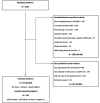Parental stress, depression, anxiety and participation to care in neonatal intensive care units: results of a prospective study in Italy, Brazil and Tanzania
- PMID: 39106992
- PMCID: PMC11664376
- DOI: 10.1136/bmjpo-2024-002539
Parental stress, depression, anxiety and participation to care in neonatal intensive care units: results of a prospective study in Italy, Brazil and Tanzania
Abstract
Background: Studies comparing the frequency of different mental health conditions across different settings and evaluating their association with parental participation in newborn care are lacking. We aimed at evaluating the frequency of parental stress, anxiety and depression, along with the level of participation in newborn care, among parents of newborns in Italy, Brazil and Tanzania.
Methods: Parental stress, anxiety, depression and participation in care were assessed prospectively in parents of newborns in eight neonatal intensive care units (NICUs) utilising: the Parental Stressor Scale in NICU (PSS:NICU); the Edinburgh Postnatal Depression Scale (EPDS) and EPDS-Anxiety subscale (EPDS-A); the Index of Parental Participation in NICU (IPP-NICU). Univariate and multivariate analyses were conducted.
Results: Study outcomes were assessed on 742 parents (Brazil=327, Italy=191, Tanzania=224). Observed scores suggested a very high frequency of stress, anxiety and depression, with an overall estimated frequency of any of the mental health condition of 65.1%, 52.9% and 58.0% in Brazil, Italy, Tanzania, respectively (p<0.001). EPDS scores indicating depression (cut-off: ≥13 for Brazil and Tanzania, ≥12 for Italy) were significantly more frequent in Tanzania (52.3%) when compared with either Brazil (35.8%) and Italy (33.3%) (p<0.001). Parental participation in care was also significantly higher in Tanzania (median IPP-NICU=24) than in the other two countries (median=21 for Brazil, 18 for Italy, p<0.001). Severe stress (PSS:NICU ≥4) was significantly more frequently reported in Brazil (22.6%), compared with Italy (4.7%) and Tanzania (0%, p<0.001). Factors independently associated with either parental stress, anxiety or depression varied by country, and a significant association with parental participation in care was lacking.
Conclusions: Study findings suggest that parental stress, anxiety and depression are extremely frequent in NICUs in all countries despite diversity in the setting, and requiring immediate action. Further studies should explore the appropriate level of parental participation in care in different settings.
Keywords: Neonatology.
© Author(s) (or their employer(s)) 2024. Re-use permitted under CC BY-NC. No commercial re-use. See rights and permissions. Published by BMJ.
Conflict of interest statement
Competing interests: None declared.
Figures






References
-
- UNICEF. World Health Organization. World Bank Group . New York: United Nations Children’s Fund; 2022. [05-Dec-2022]. Levels & trends in child mortality 2022.https://data.unicef.org/resources/levels-and-trends-in-child-mortality/ Available. accessed.
-
- United Nations Inter-agency Group for Child Mortality Estimation (UN IGME) New York: 2023. Never forgotten: the situation of Stillbirth around the globe, United Nations children’s Fund.
MeSH terms
LinkOut - more resources
Full Text Sources
Medical
